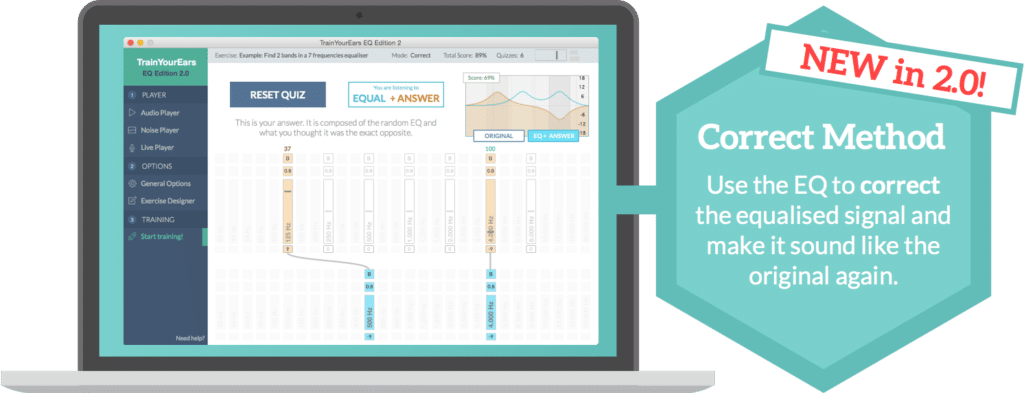Last Updated on February 28, 2023 by IDS Team
For guitar, music ear training apps can be of varying quality. Yet here, we review the best and simplest which shines because it includes the MOST relevant and easy-to-understand parts of the mixing process.
This is Train Your Ears EQ Edition. As a guitarist who tried to learn EQ from tutorials online, I found the immersive experience of Train Your Ears was the missing link I needed. We’ve reviewed it in general before, plus we’re also covering how it worked for electronic musicians this month – but here, read on for why it’s so great when adapted to guitar.
OK, why is Train Your Ears so great for guitar music ear training?
This involves two things that make it stand out. The first is it looks at patterns, not learning by rote. The second is that it’s adaptable to however you want to use it.
When we say Train Your Ears teaches you patterns, this means that the developers have looked at the crucial building blocks of understanding EQ and focused on showing how you can use them and apply them to anything. This links to how it’s adaptable. Train Your Ears doesn’t teach you in a fixed context. It simply gives you the independent ability to apply your knowledge to whatever tracks you like.
As guitarists, who are often more used to doing things by ear, this can work amazingly.

Is Train Your Ears easy to use?
I personally found the setup for Train Your Ears to be really intuitive as they basically do everything for you on the website. After downloading the app, you drag it to the folder you desire on your laptop as usual and you’re presented with a page of options when you first start it up, one of which is ‘play some music’.
To do this you can use any track, whether one of your own or something from your favorite bands. I used a track from the modern UK grunge band Dirty Modal Souls, so there was plenty of delicious crunchy guitar to practice ear training with. However, you’ve first got to get the track to play in the app.
This is a simple drag and drop to the audio player, so you can add the track as an m4a file from your iTunes library or as an mp3 file or WAV file – the choice is yours and sometimes it can help to use a variety so you can hear the difference between compressed and uncompressed audio.
Using the app this way makes it fun to practice as you are listening to your favorite music at the same time.
How can I use Train Your Ears when practicing?
You can actually get the app to play tracks directly from your iTunes library, as in order to do the exercises you need the track to play live. You can do this by routing the audio of your computer so that train your ears receives audio input internally direct from your laptop.
If you’re using iOS, you need to download BlackHole which fortunately you can do from the train your ears website live player page here. However, when you have the app open it also gives you simple instructions. If on Windows, you can likewise use the program VB cable which you can also get from the website we’ve linked above.
After running the installer and following the instructions on the train your ears website to route your internal audio correctly, you’re all set and can play from iTunes and other places on your computer.
Likewise, you can use your audio interface to route external audio such as from an iPod or other music player.
Best guitar music ear training tips: how to get the MOST out of this software
- Ensure you’ve got the right song for the exercise
It goes without saying, but make sure you pick the right song for the exercise. If you’ve always struggled with separating bandwidths in big walls of sound, pick a song that has this and hop on board with the first exercise, recommended by Train Your Ears, which is on guessing which bandwidths have been modified.
As a beginner exercise, this is simple and easily helps you understand the quirks and nuances of different bandwidths and what they sound like. This ranges from the echoing, booming sounds that come from giving the middle a boost or the way cutting lower frequencies can make your track sound toppy or thin.
However, the exercises do get harder.
- Use multiple tracks in the same genre as reference points
Another way to get the most out of Train Your Ears is to use multiple tracks so you’re not just practicing within one environment. Using multiple tracks helps you spot the patterns of sound between tracks and genres. You’ll end up knowing what compression or different bandwidth cuts sound like despite what’s going on with the rest of the instruments.
Ultimately by learning the patterns and processes behind mixing audio, you will end up with an aural skillset that can help you adapt to any track.
As a guitarist, to vary things it helps to practice on a couple of slow tracks with less guitar (such as ballads) as well as with a couple where there’s more going on, such as anything with double-tracked guitar or layers of sound. Focusing on guitar solos is also a separate area as here you’ll gain experience with frequencies up at the high end of the spectrum and how they change based on other instruments.
So, why does Train Your Ears work so well for guitar music ear training?
The takeaway is, nothing exists in isolation. Although Train Your Ears is deceptively simple at first, it provides a really comprehensive set of exercises that offer you new challenges in new contexts based on the tracks you choose to use, so keep challenging yourself, and it will likewise keep challenging you – and pay off, as well,
It doesn’t try to teach you – it lets you teach yourself (and it’s easy to set up!)
Train your ears allows you to adapt the exercises to whatever your preferred genre is. This makes it consistently relevant to your playing, even down to what you may be working on RIGHT NOW> By doing away with orthodoxy, set teaching programs, and conventional ways of doing things, it works with how many guitarists learn in the first play.
Final Thoughts
Ultimately I found Train Your Ears works because it reminded me of learning to play guitar in the first place – I was teaching myself and learning about how the fretboard worked in the context of my favorite songs. Train Your Ears does just that with the EQ spectrum and more. It covers pairs of contrasts such as high cut and low shelf filters as well as challenging you from new angles such as with exercises that ask you to find bandwidths. Ultimately it’s a program you can keep returning to, because it stays consistently relevant to whatever you’re currently working on. Plus, it doesn’t become too easy, because of the sheer variety of ways in which you can use it.
Train Your Ears is available from their website and is currently reduced to 49 EUR. You can check the Train Your Ears website by clicking here. We are affiliated so if you click on our link and buy the product, we get a small payment which supports the work we do here at idesignsound.com.
If you love reviews, we have more of them in our reviews section where we break down other fantastic software for guitar and more!



